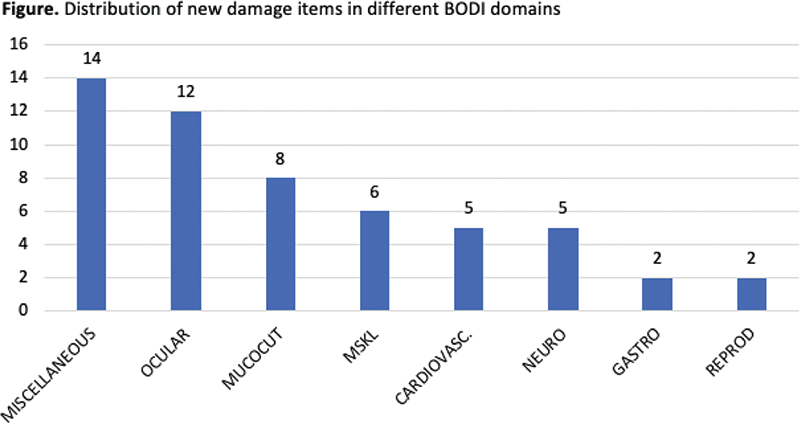

Background: Preventing accrual of organ damage is a major goal in the treatment of Behçet’s Syndrome (BS). The BS Overall Damage Index (BODI) is the first damage assessment tool developed and preliminarily validated for BS.
Objectives: To assess the prevalence, extent, and determinants of organ damage accrual in the BODI validation cohort over 24 months of follow-up.
Methods: Overall, 189 patients from the multicenter BODI cohort underwent a 24 ±3 months follow-up (FU) visit. Demographics, ongoing medication, Behçet’s Disease Current Activity Form (BDCAF) score, Physician (PGA) and Patient Global Assessment (PtGA) of disease activity, disease relapsing (defined by any treatment change due to increased disease activity), and the BODI score were recorded. Damage accrual was defined as any increase ≥1 in the BODI score between baseline and follow-up visit (Δ-BODI). Logistic regression models were built to identify factors associated with BODI damage accrual.
Results: The mean age (standard deviation) at enrolment and the disease duration was 46.2 (12.1) and 10.8 (8.3) years, respectively, and 92/189 (48.7%) patients were males. During 24 months, 36 (19.0%) patients had an increase in the BODI score of at least 1 point (mean increase of 1.7 points). The BODI score increased from 1.6 (2.1) to 1.9 (2.1), with a mean Δ-BODI of 0.3 (0.8). Overall, 61 new BODI items of damage were recorded (
Determinants of organ damage accrual over 2 years of follow-up.
| Univariate analysis | Multivariate analysis | ||||
|---|---|---|---|---|---|
| Candidate determinants | Δ-BODI ≥1 (n 36) | Δ-BODI = 0 (n 153) | p | OR (95%CI) | p |
| Males | 16 (44.4%) | 76 (49.7%) | 0.572 | ||
| Age at enrolment | 56.2 (42.9-62.0) | 46.6 (35.4-53.1) | 0.001 | -- | -- |
| Disease duration | 12.9 (7.1-22.0) | 11.1 (5.4-21.2) | 0.483 | ||
| Major organ involv. | 22 (61.1%) | 72 (47.1%) | 0,129 | ||
| BDCAF at BL | 3 (0-5) | 2. (0-5) | 0.365 | ||
| BDCAF at FU visit | 3.0 (3-5) | 3 (0-7) | 0.188 | ||
| GC duration | 112 (26.0-147.0) | 24.0 (8.0-72.0) | <0.001 | 1.012 (1.006-1.018 | <0.001 |
| cIS or TNFì ever | 24 (66.7%) | 133 (86.9%) | 0.004 | 0.194 (0.073-0.972 ) | <0.001 |
| Relapse | 9 (25.0%) | 20 (13.1%) | 0.070 | 3.093 (1.066-8.972 ) | 0.038 |
| BODI score at BL | 1.0 (0-2.0) | 1 (0-2) | 0.579 | ||
Continuous variables are presented as median (IQR). Dichotomic variable are presented as n (%). BODI, Behçet’s Syndrome Overall Damage Index. FU, follow-up. cIS, conventional immunosuppressant. Δ-BODI increase of BODI score from baseline to the FU visit.
Conclusion: Despite the relatively high disease duration in the studied cohort, organ damage accrual was recorded in a relevant proportion of patients. BODI proved to capture the damage associated with major determinants such as inadequate control of disease activity and prolonged exposure to glucocorticoids.

Disclosure of Interests: None declared